As an Amazon Associate, we earn from qualifying purchases with no additional costs for you.
A Santoku knife is a popular Japanese knife choice in the kitchen, and many first-time Japanese knife buyers add a Santoku to their collection first. Why is the Santoku popular, and how can you get one without blowing your budget?
The Santoku is one of the most famous Japanese kitchen knife designs, alongside the Gyuto, or chef’s knife. The Santoku is versatile and can perform many cutting, slicing, dicing, and chopping tasks in the kitchen. The knife is light, and the shorter blade makes the knife handy for quick work.
Next to the Gyotu, the Santoku is a prime choice for someone looking to try out a Japanese knife or a versatile kitchen knife. The traditional characteristics and the blade design of the Santoku contribute to the continuous high demand for this knife. We will discuss why you should own one of these knives and your options on how to get one at a fair price.
If you are interested in checking out the best Santoku knife made by Hayate Yoshihiro, we recommend and personally use you can find it by clicking here (Amazon link).

Choosing A Santoku Knife
Japanese kitchen knives are seen as the pinnacle of kitchen knives, and it has become prestigious to own them and use them in your kitchen.
The reputation of these knives is well deserved due to the consistently high quality of the knives coming out of Japan and the purpose-built design for each type.
The Japanese high-carbon steel allows the blade to be hardened to a higher HRC rating than most Western steel types.
The rugged steel allows Japanese knives to be sharpened to an ultra-sharp level, and the blade holds the edge well.
These reasons are why Japanese knives are so popular, but the Santoku has a reputation that makes it sought-after as a first-time Japanese knife.
The name “Santoku” means three virtues or three purposes, indicating that this is a multipurpose knife in the kitchen.
This versatility is unusual in Japanese knives since most are made for a singular purpose. A Santoku offers value for money because it can be used as a general-purpose knife in the kitchen rather than for a single task.
So, what features of a Santoku knife make it a good choice for a first Japanese kitchen knife?
What Are The Features Of A Santoku Knife?
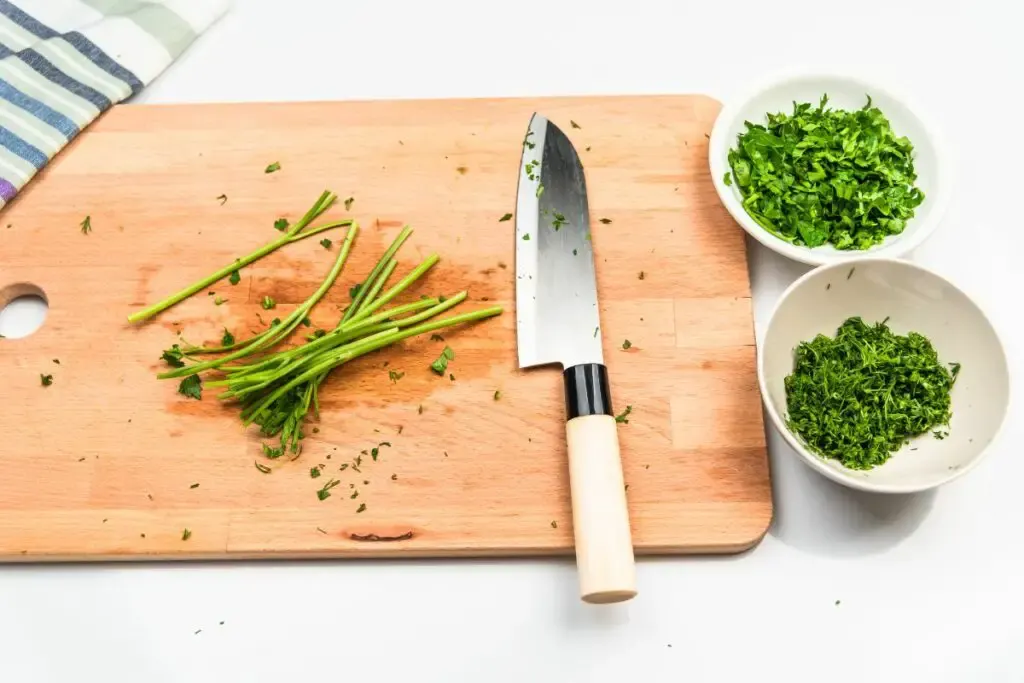
Santoku knives come in a range of blade lengths, from 6.5 inches to 7 inches or 165mm to 180 mm, which adds to their versatility in the kitchen.
The shorter blade makes for more agility in the kitchen and requires less space on the countertop to process ingredients.
The Santoku blade is shorter than most Gyuto, or chef’s knives, but the blade height can be as high or higher than a Gyuto.
The additional height allows for more knuckle space above the chopping surface when processing vegetables.
Speaking of ingredients, the knife can be used to process; the blade is designed to cut meat, fish, and vegetables. Hence, the “three virtues” are alluded to in the knife’s name.
Santoku Blade Design
The knife’s upper edge, or spine, is flat until it curves steeply down to the tip in an almost sheep’s foot tip design.
This is a safety feature in the design that allows the user to rest their non-dominant hand safely on the tip of the blade to assist with the chopping motions of the knife’s heel. This technique is often used for fast chopping or mincing herbs and soft vegetables.
The cutting edge is flat for the most part from the heel of the blade, with a slight curve in the last section of the edge towards the knife’s tip.
This design feature allows for a rocking chopping motion, a popular method for processing herbs and vegetables fast.
Traditionally, the Santoku is a single-bevel knife, but many Japanese knifemakers produce double-bevel versions to cater to the Western market, which prefers this edge design.
This deviation from tradition is good news because it allows for the knife’s left- or right-handed use and a double bevel is easier to sharpen.
BTW: If you want to know more about Japanese and other knives and their sharpening, check out the books listed above. These books are recommended by professional sharpeners and knife makers (Amazon links):
- Japanese Kitchen Knives: Essential Techniques and Recipes
- The Knifenerd Guide to Japanese Knives
- Knife: The Culture, Craft, and Cult of the Cook’s Knife
- Sharp: The Definitive Introduction to Knives, Sharpening, and Cutting Techniques, with Recipes from Great Chefs
The Santoku Handle Design
Some Santoku manufacturers produce their knives with Western and traditional Wa-style handles.
The knife tang in Wa-style handles is a partial tang, which reduces the knife’s overall weight and places the balance point on the blade, which is ideal for processing ingredients.
Western-style handles may be full or partial tang knives, but I think these handles detract from the overall Japanese knife experience.
TIP: There are two main knife design types concerning the handle end of the knife: full and partial tangs. Find out more in the article below:
All You Need to Know About Knife Tangs (Full or Partial?)
How Can You Use A Santoku?
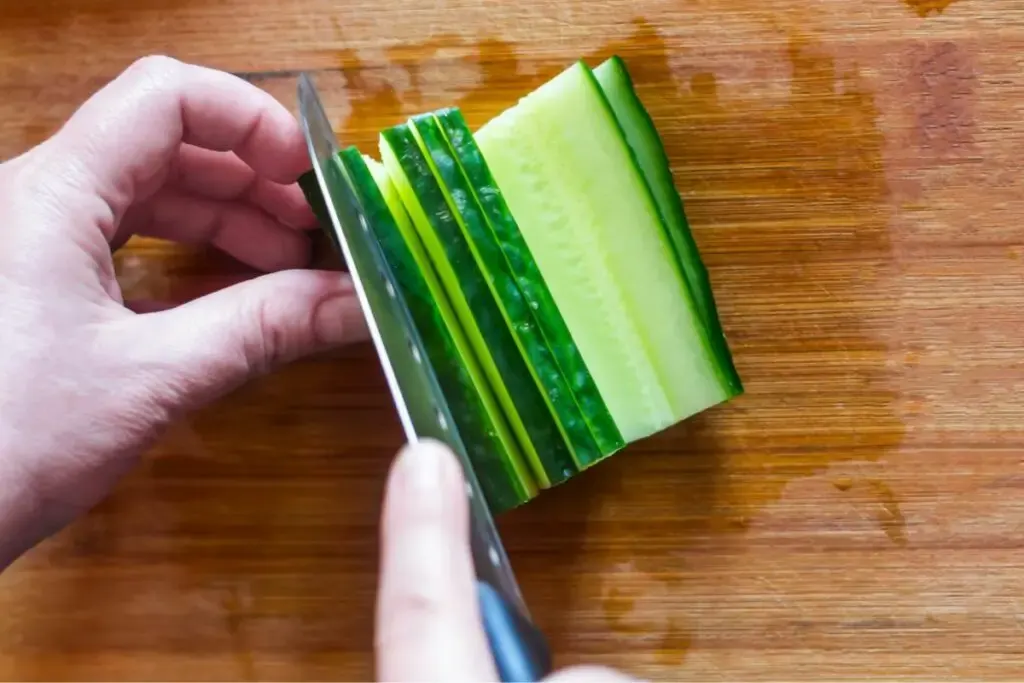
One of the main attractions of the Santoku in the kitchen is its versatility, which makes this knife a popular choice for first-time Japanese knife buyers.
A Santoku can be used in the following ways in the kitchen.
- Slicing. The long, flat part of the cutting edge makes the Santoku a good slicer. It is perfect for slicing julienne vegetables, meat, fish, or deboned poultry. The ultra-sharp edge allows for slices as thin as you would like. Cutting soft ingredients such as tomatoes is a breeze without bruising the ingredients by applying too much pressure.
- Dicing. The curve of the cutting edge at the tip of the blade allows for easy dicing of fruit, herbs, or soft vegetables using a rocking motion.
- Mincing. The Santoku can effectively mince herbs and vegetables into fine, delicate pieces that enhance flavor and presentation.
- General cutting tasks. The excellent length of the Santoku blade makes it ideal for many general cutting tasks. You will often reach for this knife for general kitchen duties!
Features To Look Out For In A Santoku Knife
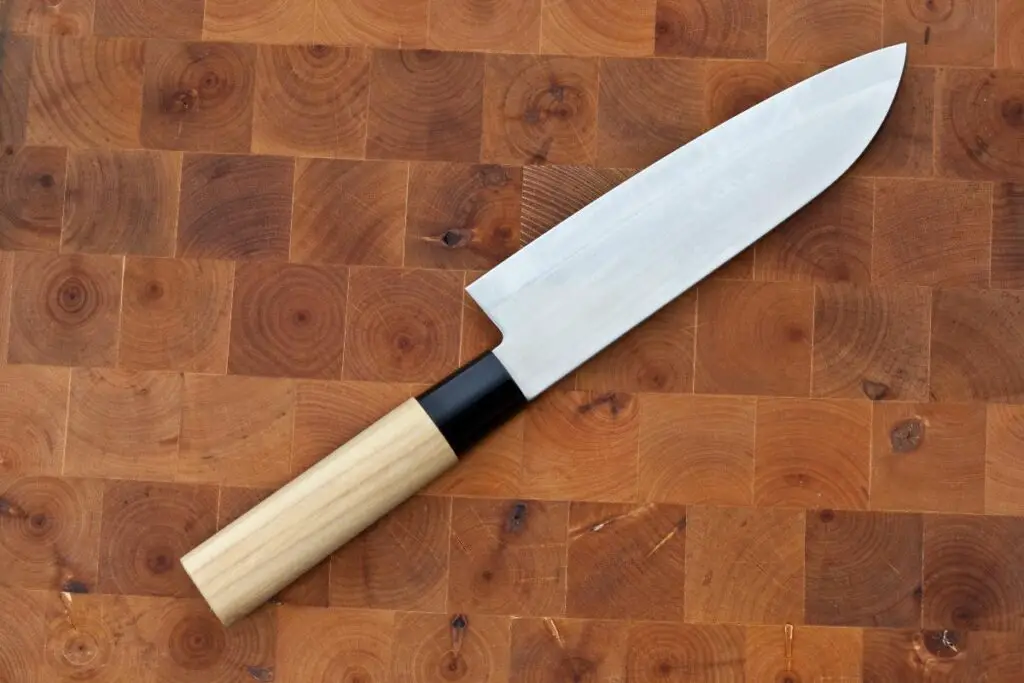
There are several aspects to look at when selecting a Santoku, which will help you choose the best possible knife for your kitchen.
The most important aspect of the knife to investigate is the steel used to manufacture the blade. This will determine the edge-holding capability of the knife, its longevity, and its performance.
Japanese high carbon or stainless steels are the best options to go for in knife steel, but you will pay a premium for blades made from these quality materials.
The knife’s blade length is key to ensuring the knife is comfortable and safe for you to use. Most Japanese knives come in a range of lengths, so select a length appropriate for your stature and hand size.
Handle material and shape can affect the experience you have with the knife. Some people prefer the Western-style knife handles, while others prefer the traditional Wa-style handles.
Some people prefer the Western-style handle because they feel this design is more safety-oriented and the handle style they are most comfortable using.
I recommend using the traditional handle design since this option keeps your hand in the correct position to use the knife for its intended purpose and reduces hand fatigue.
TIP: Japanese kitchen knives are considered the ultimate kitchen tools and offer prestige in the kitchen. Check out the complete list of Japanese knives in the article below:
All Japanese Knife Types Explained (Purpose, Usage & More)
Best Santoku Knife
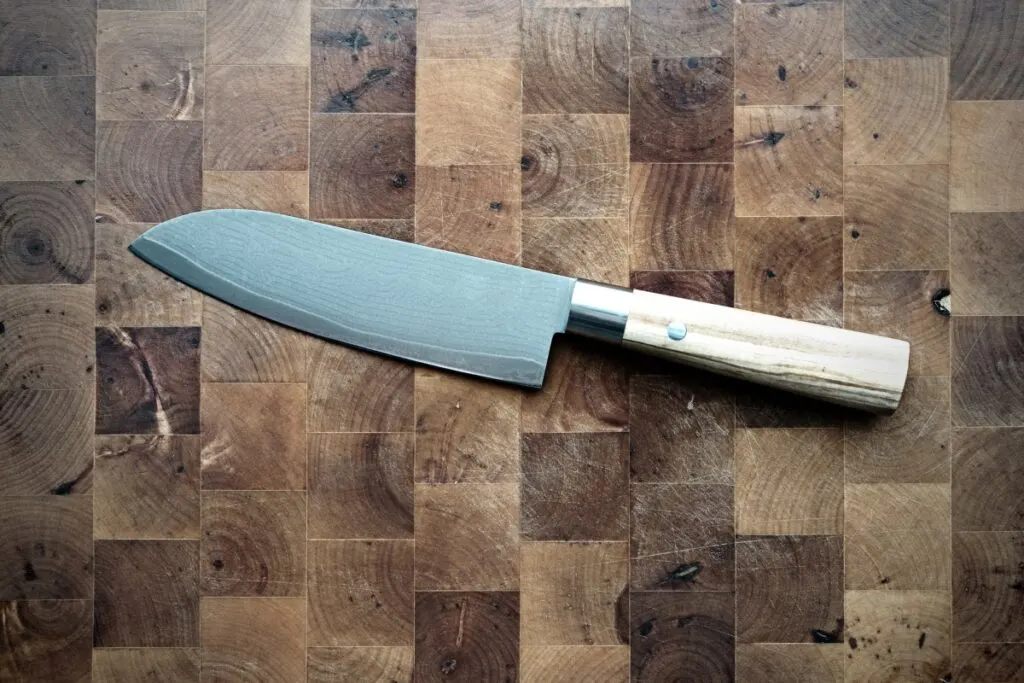
In the best Santoku knife category, we have selected a knife from a well-known, reputable Japanese knife manufacturer, Yoshihiro.
The Yoshihiro NSW Hammered Damascus Santoku (Amazon link) is an exquisite top-notch Santoku created using traditional methods and designs.
The steel used is VG-10, a Japanese stain-resistant steel perfect for making premium kitchen knives. The blade is crafted from Damascus steel made from 46 layers of softer steel covering the VG-10 steel core and given a hammered, textured finish on the upper half of the blade.
The hammered texture is more than just for aesthetic purposes! The small indentations from the hammer blows break the surface tension between the ingredients and the food and help prevent the elements from sticking to the blade.
The steel is hardened to 60 on the HRC scale, which allows the blade to be fragile for lightweight and agile performance and honed to an extremely sharp edge.
Although this manufacturer produces traditional Japanese knives, this model has incorporated some concessional features to make it more appealing to the Western market.
The 7-inch or 180mm blade is double-beveled, making the knife suitable for both left and right-handed people. The cutting edge has a slightly more exaggerated curve to promote easier chopping using the rocking motion technique.
The handle is a traditional Wa-style, octagonal-shaped handle with a Shitan rosewood bolster and redwood handle.
The knife comes with a traditional Saya, a wooden sheath to protect the blade and the cutting edge when the knife is not in use. The Saya is made from light-colored Magnolia wood, which compliments the dark wood on the knife’s handle.
This Santoku is beautiful and functional and will be a pleasure to use each time you cook in your kitchen!
Alternative: Santoku Knife Made by Tojiro
For a slightly cheaper alternative, we have chosen a Santoku made by a Japanese knife manufacturer, but with a more Western look and feel.
Even though the knife design looks more Western than Japanese, the steel quality has not been compromised. Tojiro is a recognized brand of Japanese kitchen knives and makes a range of knives from varying steel types, designs, and price points.
The company makes knives in traditional Japanese and Western designs, offering choices for the type of knife you find most comfortable.
The Tojiro Fujiro Santoku (Amazon link) is an excellent alternative to the Yoshihiro knife we have already mentioned. Still, it does not offer the whole Japanese knife experience due to westernizing some components.
The blade is made from a cobalt alloy stainless steel, making the knife easy to clean and resistant to corrosion. The 6.7-inch or 170mm blade does not have layered Damascus or a fancy finish, but this does not detract from the blade’s performance.
The blade has a double-bevel cutting edge, making it easy to sharpen and usable by right and left-handed knife users.
The knife’s handle is where the Western influence in the blade is most apparent. This Santoku features a western-style handle made from black ECO wood, a laminated product that feels more like plastic.
No Saya or sheath is included with the Tojiro Fujiro Santoku
The Tojiro Santoku is a no-frills knife that does not have the same flair as the Yoshihiro Santoku, but its price point is lower and more affordable to a more comprehensive budget range.
Budget Option: Santoku Knife by Henckels
Our selection for a budget Santoku knife is more a Japanese-style knife, made by a Western knife manufacturer, than a proper Japanese knife.
Henckels is a German knife brand, but the knives they produce are made in several European countries.
The Henckels Classic Santoku (Amazon link) is a prime example of this distributed manufacturing model. The knife is made from high-quality German stainless steel, but the blade is produced in Spain.
The blade length is 7 inches or 178mm, and it has a satin finish with a Granton edge to limit ingredients sticking to the blade’s flat.
The bolster is integrated into the knife steel, making for a well-balanced transition between the blade and handle.
The handle is a western-style, full tang handle with durable, easy-to-clean thermo-plastic handle scales riveted to the stainless steel tang.
The steel is not Japanese and, therefore, cannot be hardened to the same level. As a result, the blade is a little thicker than a traditional Japanese Santoku, and the edge retention is not as good.
While this knife is not a true Japanese Santoku, it is still a quality knife, following the standards of the German knife manufacturing company.
This knife costs a little more than half that of the Tojiro Santoku and about one-third the price of the Yoshihiro Santoku, making it an affordable, good-quality knife.
The Henckel Santoku is an excellent way to try a Japanese-style knife before you commit to the cost of the real thing!
BTW: If you are interested in buying the best cutting board, you can find our recommendations below:
- The best overall: Virginia Kitchen Boys Cutting Board (Amazon link). This fantastic cutting board is made from sustainable walnut wood from the United States and brings almost perfect safety when cutting with your knives.
- Alternative: Yoshihiro Cutting Board (Amazon link). Professional traditional Japanese cutting board that chefs around the world use.
- Cheaper option: Shun Cultery Cutting Board (Amazon link). Another Japanese cutting board stands out, especially for its simplicity and affordable price.
Santoku Knife Maintenance and Care
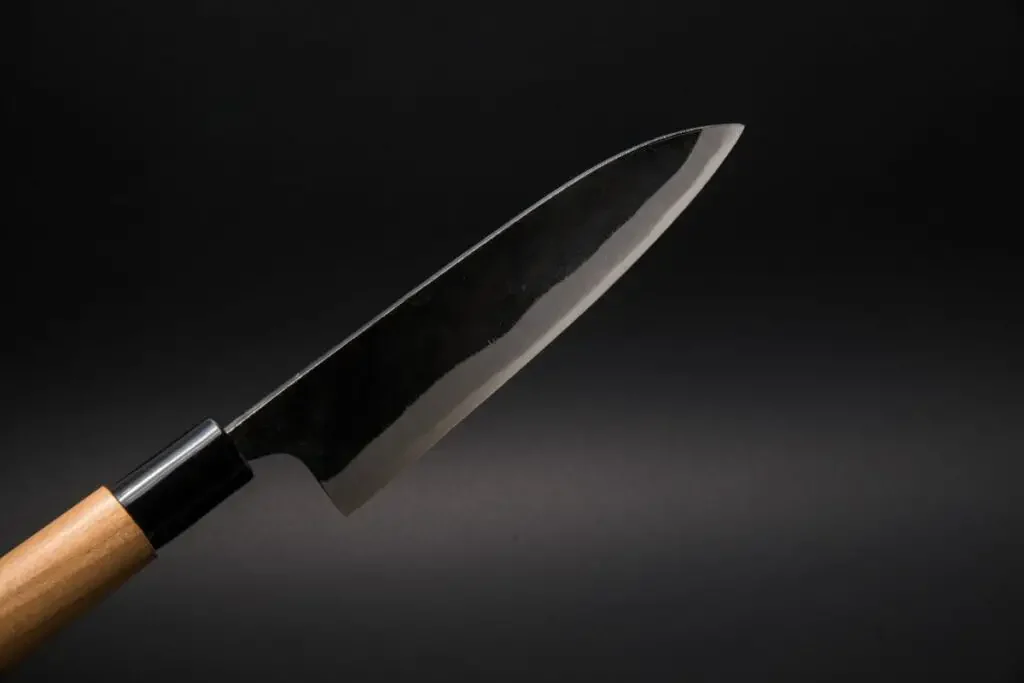
Owning a high-quality Santoku knife is an investment in your culinary toolkit. To ensure that your knife remains in top condition and serves you well for years to come, it’s crucial to understand and practice proper maintenance and care.
This section will guide you through the essential aspects of Santoku knife maintenance, including cleaning, storage, and sharpening.
Cleaning Your Santoku Knife
Hand Washing: Always hand wash your Santoku knife with mild dish soap and warm water. Dishwashers can be harsh on the knife’s edge and handle.
Immediate Drying: After washing, dry the knife immediately with a soft towel to prevent water spots and rust formation.
Avoid Abrasives: Steer clear of abrasive sponges and harsh chemicals that can damage the blade’s surface.
Storing Your Santoku Knife
Knife Block or Magnetic Strip: Store your Santoku knife in a knife block or on a magnetic strip. This prevents the blade from coming into contact with other utensils, which can dull the edge.
Blade Guards: If storing in a drawer, use a blade guard to protect the knife’s edge and ensure safety.
Sharpening Your Santoku Knife
Regular Honing: Regularly hone your knife using a honing rod to maintain the edge. This doesn’t sharpen the blade but realigns the edge, keeping it sharp.
Professional Sharpening: Periodically, have your knife professionally sharpened, especially if you notice it becoming dull. Professionals can maintain the correct angle and edge integrity.
DIY Sharpening: If you prefer to sharpen the knife yourself, use a whetstone and learn the proper technique to maintain the blade’s angle and sharpness.
Additional Tips
Avoid Cutting Hard Surfaces: Use a proper cutting board to avoid blunting the knife’s edge. Hard surfaces like glass or metal can damage the blade.
Use for Intended Purpose: Santoku knives are versatile but using them for inappropriate tasks like opening cans or cutting frozen food can damage the blade.
Regular Inspection: Regularly inspect your knife for any signs of wear or damage. Early detection can prevent further deterioration.
By following these maintenance and care tips, your Santoku knife will remain a reliable and efficient tool in your kitchen, ensuring precise cuts and a pleasurable cooking experience.
Conclusion
Santoku knives are some of the most famous Japanese kitchen knives due to the versatility of their design. They are smaller than a Gyuto but larger than a Petty or a Deba, making the Santoku the ideal mid-sized knife in the kitchen for many different tasks.
The versatility of the knife design represents value for money in a knife that can perform various kitchen tasks. Choosing a quality Santoku will ensure you have an excellent general-purpose knife in your kitchen that you will soon be unable to live without!
TIP: Gyuto knives are versatile Japanese knives used for various kitchen tasks, from chopping fruits, vegetables, and herbs to cutting meat and fish. Check out the best Gyuto knives in the article below:
4 Best Gyuto Knives For Your Kitchen (Under $100 And $200)

